 The Controls & Cockpit Drill
The Controls & Cockpit Drill 
 The Controls & Cockpit Drill
The Controls & Cockpit Drill 
Doors
Closing - As the driver you are responsible for ensuring all the doors are properly closed, listen to hear all the passenger doors are closed and then check in the side mirrors to ensure they are flush with the side of the car.
It is also advisable to lean across the front seat passenger to physically check that their door is properly shut.
Opening - Careless opening of the doors can cause danger to ourselves and others and we must always check to ensure it is safe before opening the doors.
The Seat
Now the seat needs to be adjusted so that we are positioned comfortably and can operate all the controls correctly:
Position - The seat is moved back and forth by lifting the lever under the left side of your seat and then adjusting the seat until you can push the left pedal (the cutch) all the way to the floor whilst maintaining a slight bend at the knee. Once you are happy with the seat position release the bar and check to ensure the seat will not move.
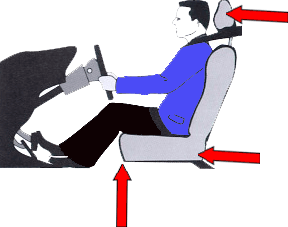
Rake - Now we are seated correctly for our feet to reach the foot pedals we need to adjust the back of the seat so that we can steer comfortably. The back of the seat can be adjusted by moving slightly forward in the seat and turning the small wheel at the left side of the drivers seat. We should be able to hold the steering wheel with our hands at the ten to two position and slide them both to the bottom of the steering wheel comfortably.
Head Restraint - Now we need to check the head restraint. The head restraint is a safety device which needs to be properly adjusted to reduce the risk of injury to your head and neck in the event of a collision or emergency braking. It is adjusted by moving it up or down to a position so that the top of the headrest is level with your eyes or ears and is close to your head as is comfortable.
Seatbelt - Now is the time to put your seatbelt on. Except in certain circumstances, everyone traveling in the vehicle is legally required to wear a seat belt. You need to be aware of your responsibilities as a driver regarding the wearing of seatbelts in the car.
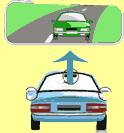

The Mirrors
We need to know what is going on all around us when driving in order to obtain all the information we need to make safe driving decisions, so we need to make sure the mirrors are properly adjusted to get the best possible view to the rear and the sides.
Most cars are fitted with 3 mirrors:
The interior mirror and 2 exterior mirrors
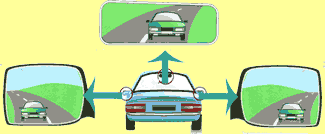 The interior mirror is made of flat glass whilst the exterior mirrors are slightly curved (convex). The exterior mirrors enable a wider view to the rear and sides but the diagram to the right demonstrates that vehicles will appear to be further away in the exterior mirrors that in the interior mirror. It takes practice but you will soon be able to accurately judge the distance of following vehicles in any of the mirrors.
The interior mirror is made of flat glass whilst the exterior mirrors are slightly curved (convex). The exterior mirrors enable a wider view to the rear and sides but the diagram to the right demonstrates that vehicles will appear to be further away in the exterior mirrors that in the interior mirror. It takes practice but you will soon be able to accurately judge the distance of following vehicles in any of the mirrors.
Mirrors - Signal - Manoeuvre
Which brings us to the most important routine in driving - when driving we need to know what is happening around us and also make our intention to make a manoeuvre clear to other road users. To do this we employ a basic safety routine that is known as MSM which stands for:
Mirrors - Signal - Manoeuvre
I will explain how to use the MSM routine in various situations when they arrive during your training - for now try to remember that we need to look in the mirrors when slowing down or stopping, signaling, changing direction, moving off, overtaking and before opening the car door.
That concludes your introduction to the cockpit drill I'll show you how to adjust the mirrors to get the best possible view when we see how to do the cockpit drill in the car.
[Introduction][Cockpit Drill][Foot Controls][Hand Controls][Other Controls]
This tutorial should be studied in conjunction with:

Driving - the Essential Skills page 28
Driving - the Essential Skills pages 30 - 63
Driving - the Essential Skills page 66
The Highway Code - rules 73,75,76,97
This will be your introductory lesson and we will be learning about the safety checks that need to be completed on entering the car and the position and method of operation of some of the main controls.
By the end of the lesson you will be able to prepare the car for moving off safely, start the engine and if we have time we will begin to learn about moving off from a parked position and stopping the car.
Click on the link - Cockpit Drill to find out more, or use the links below to find out about the car controls:
Foot Controls
Hand Controls
Other Controls
The Cockpit Drill
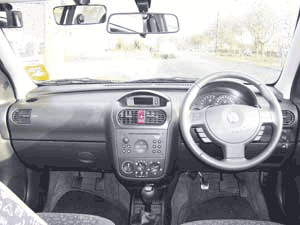
Whenever we enter the car we should always complete the routine known as the "Cockpit Drill".
The cockpit drill is designed to ensure that we are seated correctly, comfortably and in a position to operate the car controls safely and efficiently.
You may find it difficult to remember the cockpit drill at first - don't worry - everyone does and you will soon become familiar with it so that you will be doing it confidently whenever you have a lesson.
The cockpit drill needs to be done every time we get into the car. First we'll be doing a safety check - Handbrake Secure
Handbrake Secure
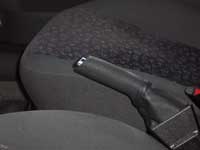
The first thing to do on entering the car is to check that the handbrake is holding the car stationary. The handbrake is on when the lever is up and is off when it is down to the floor. To check that the handbrake is on, take hold of the handbrake and put your thumb over the button - pull the lever up with a slight pressure - if there is a firm resistance to the upward movement then the handbrake is on.
You will learn more about the handbrake when you read about the hand controls.